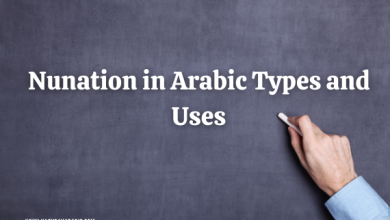Understanding how to use relative pronouns in Arabic can significantly enhance your grasp of the language. Whether you’re a beginner or looking to refine your skills, this guide will help you master the use of relative pronouns to create clear and precise sentences.
Introduction to Relative Pronouns
Relative pronouns are the glue that holds sentences together, linking different parts and providing additional information. In Arabic, they help clarify who or what we are talking about, making sentences more precise and informative.
What Are Relative Pronouns?
Relative pronouns are words used to connect clauses or phrases to nouns or pronouns. They provide additional details about the noun or pronoun they refer to. In Arabic, relative pronouns function similarly to their English counterparts, such as “who,” “which,” and “that.”
The Role of Relative Pronouns in Arabic
In Arabic, relative pronouns are crucial for:
- Adding Details: They introduce relative clauses that provide more information about a noun.
- Clarifying Meaning: They help specify which person or thing is being talked about.
- Linking Sentences: They connect different parts of a sentence, enhancing readability and coherence.
Common Relative Pronouns in Arabic
The primary relative pronouns in Arabic include:
- الذي (al-ladhi) – “who,” “that,” or “which”
- التي (al-lati) – “which” or “that” (feminine)
- الذين (al-ladhina) – “those who”
Each of these pronouns has specific uses based on gender, number, and context.
How to Use ‘الذي’ (Who/That)
الذي is the most versatile relative pronoun in Arabic. It can be used for both masculine and feminine singular nouns and can refer to people or things. For example:
- Masculine: الرجل الذي قرأ الكتاب (The man who read the book)
- Feminine: المرأة التي ذهبت إلى السوق (The woman who went to the market)
Using ‘التي’ (Which)
التي is used for feminine singular nouns. It serves to link additional information about a female subject or object. For example:
- Feminine: السيارة التي اشتريتها جديدة (The car which I bought is new)
The Function of ‘الذين’ (Those Who)
الذين is used for plural nouns and refers to people or things. It helps in providing information about groups. For example:
- Masculine Plural: الطلاب الذين نجحوا في الامتحان (The students who passed the exam)
- Feminine Plural: النساء اللواتي حضرن المؤتمر (The women who attended the conference)
Understanding ‘التي’ in Different Contexts
التي can sometimes be confusing due to its different uses. It can refer to objects, places, or abstract concepts depending on the context. Understanding its application is key to mastering relative pronouns in Arabic.
Stay tuned and subscribe to our channel.
Forming Questions with Relative Pronouns
Relative pronouns can also be used to form questions. For instance:
- Masculine: من الذي فعل ذلك؟ (Who did that?)
- Feminine: ماذا التي تريديها؟ (What is it that you want?)
Relative Pronouns in Complex Sentences
In complex sentences, relative pronouns link multiple clauses, providing a seamless flow of information. For example:
- Example: الكتاب الذي قرأته البارحة هو ممتع (The book that I read yesterday is interesting)
Common Mistakes and How to Avoid Them
Common mistakes include confusing the gender and number of relative pronouns or misplacing them in sentences. Avoid these by:
- Checking Agreement: Ensure the pronoun agrees in gender and number with the noun.
- Using Correct Form: Use the appropriate relative pronoun for the context.
Practice Exercises for Relative Pronouns
Practicing with sample sentences can enhance your understanding. Try creating sentences using different relative pronouns and check if they fit the context correctly.
Tips for Mastering Relative Pronouns
- Study Examples: Analyze sentences from books or articles.
- Use Flashcards: Create flashcards for different relative pronouns and their uses.
- Practice Regularly: Regular practice helps in mastering relative pronouns.
Real-Life Applications of Relative Pronouns
Using relative pronouns effectively can improve both written and spoken Arabic. They help in constructing more complex and meaningful sentences, essential for effective communication.
Conclusion and Summary
Relative pronouns play a crucial role in Arabic sentence structure. By understanding and practicing their use, you can enhance your ability to form clear and detailed sentences, improving your overall proficiency in the language.
FAQs
1. What are relative pronouns in Arabic?
Relative pronouns in Arabic are words that link additional information to nouns, such as “الذي” (who/that), “التي” (which), and “الذين” (those who).
2. How do you use ‘الذي’ in a sentence?
Use ‘الذي’ to refer to masculine singular nouns, linking additional information. For example, “الرجل الذي رأيته” (The man who I saw).
3. When should you use ‘التي’?
Use ‘التي’ for feminine singular nouns, like in “المرأة التي قابلتها” (The woman whom I met).
4. What is the function of ‘الذين’?
‘الذين’ refers to plural nouns and is used to provide information about groups of people or things, e.g., “الأشخاص الذين جاءوا” (The people who came).
5. How can I avoid common mistakes with relative pronouns?
Ensure correct gender and number agreement and use the appropriate pronoun based on context to avoid errors.
This guide should help you effectively use relative pronouns in Arabic, enhancing both your writing and speaking skills.




